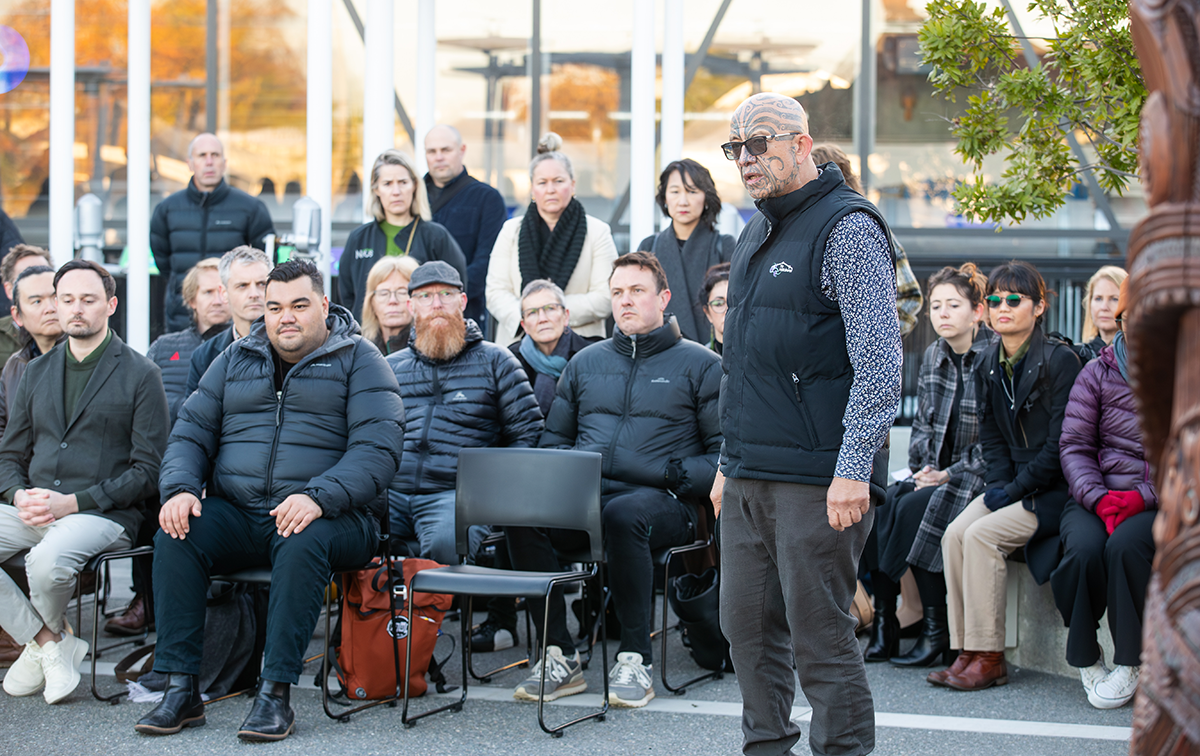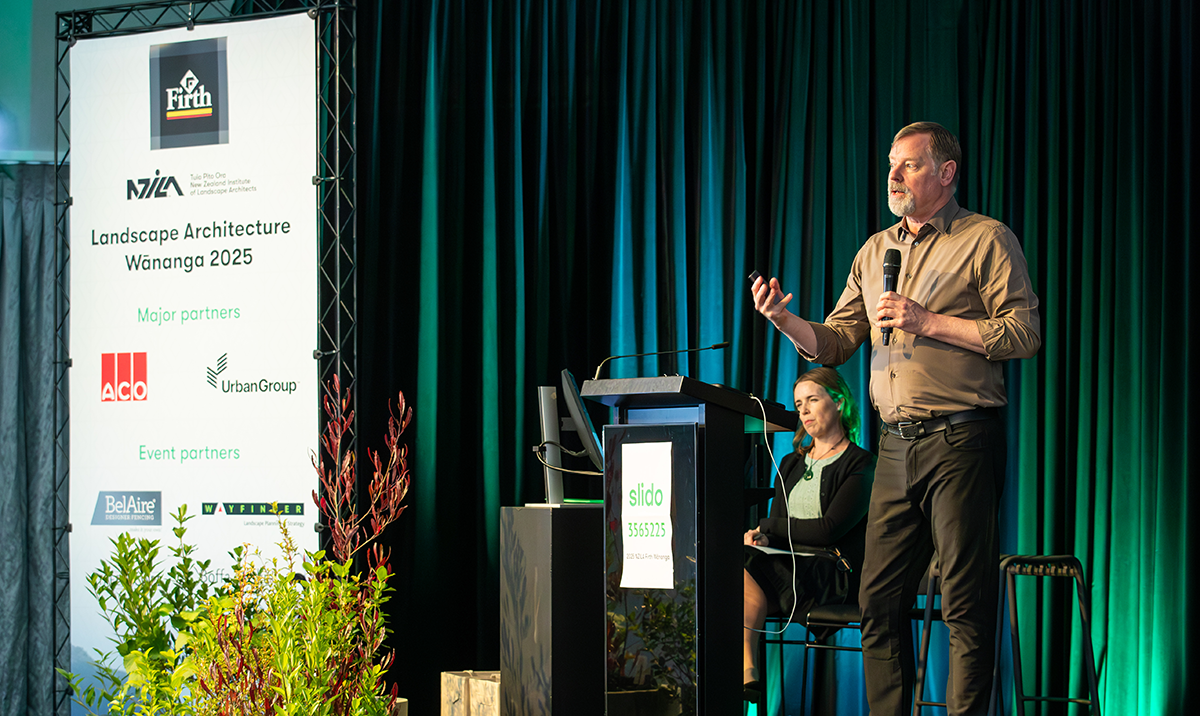A reflective walk through the NZILA Firth Wānanga 2025 (with photos)
Contributor: Alison Bentley of Tikitere Farm.
I arrived at the NZILA Firth Wānanga 2025 in Heretaunga Hastings as an ‘outsider looking in’.
The scene was set with a beautifully warm pōwhiri at Waiaroha (the Heretaunga Water Discovery Centre) on the first crisp frosty morning of the approaching winter. Threads from that scene were woven throughout the 2-day Wānanga themed “Horanuku Hora Kai | Edible Landscapes”.
So why does a small scale farmer with no formal qualifications in Landscape Architecture or science attend such a gathering and what did I take away?
Six key words: Food. Community. Environment (natural and built). Relationships. Language. Action.
These threads, fragile in today’s world, weave us all together. There is a need and passion for strengthening these threads to enable food sovereignty for every person in Aotearoa New Zealand.
Food. We all eat. Those fortunate to experience fresh fruit and vegetables (with or without meat), and are mindful of the bounty, have a burning desire to enable every person to experience what should be normal nourishment through food.
This kind of fresh, unprocessed (or minimally processed) food grows in our natural landscapes. As presented by Mel Robinson large volumes of fresh vegetables can also be designed, and produced, in built urban environments, while engaging closed-circuit waste reuse.
Community. Throughout community there is richness in skills - formal, informal and cultural. By blending western and indigenous, formal and informal, academic and practical, these rich skills can strengthen the currently fragile threads to create a resilient web to nurture food sovereignty.
Environment - natural and built. Working with papatuanuku and the intricate ecosystems provided, designing natural and built landscapes with empathy, and collaboration with human communities, will deliver food sovereignty. Remember to design in the “messy” - it supports the ecosystems!
Relationships. International guest speaker Tim Waterman talked us through the critical connections from landscapes to citizenship and landed us in a new language of “landship” - warning us of the “beige hole” that traps creativity, individuality and culture. Gratitude and celebration are so important in avoiding the beige hole.
Te Kahautu Maxwell reinforced relationships have no ruler, they are built with trust and respect - relationships with the natural world and humanity.
Language. “Use” = one way / take / extract. “Resources” = to be used. “Sustainable” = continue as is / bare minimum. Change to: Collaborate, living ecosystems to share, regenerate / foster abundance. Resource management needs to be “living - giving - systems”. CPR in the context of designing livingscapes means Connection, Protection, Respect - thanks ReneeTaylor. Our language represents our values. Values speak louder than words.
Action. Do it now. Don’t wait because life is busy. Be mindful of your food. Design environmental and community relationships into your life.
Thank you Tuia Pito Ora NZILA for day-lighting some shocking truths, and heart-warming examples of positive actions within your profession. Thanks also for the leadership and fantastic living example of how collaboration with tangata whenua creates better pathways for all.
Thank you for the warmth and welcoming environment in which a small scale farmer was able to participate.
Thank you to the partners,exhibitors and supporters.
The greatest Thank You is for every presenter for the tears, the sunlight, the connectedness; for every word, every image, and above all, your shared values.
A SMALL selection OF PhotoS & CAPTIONS from the NZILA Firth Wānanga 2025
Photo credits: Duncan Brown.
Charles Ropitini, Pou Ahurea with the Hastings District Council, addresses manuhiri at the pōwhiri for the NZILA Firth Wānanga 2025 on the opening day of Thursday 22 May.
Photo credit: Duncan Brown.
Te Kauhatu Maxwell responds to the welcome and whaikorero from mana whenua.
Photo credit: Duncan Brown.
Ngahiwi Tomoana, a prominent leader of Ngāti Kahungunu, was at the podium in the Toitoi events venue for an opening session that dove deep into the challenges posed in the Hawke’s Bay during and since Cyclone Gabrielle. His two fellow speakers were orchardist Cameron Taylor, of Taylor Corporation (at left below), and To’osavili Nigel Bickle, chief executive of the Hastings District Council (at right below). Shannon Bray, of Hastings-based firm Wayfinder and a former NZILA President, facilitated.
Photo credit: Duncan Brown.
Two renowned international speakers - Professor Tim Waterman above and Assoc. Professor Joshua Zeunert below - presented their worldviews in a session titled ‘The world perspective’. This session was sponsored by Boffa Miskell and the facilitator was Shannon Davis of Lincoln University.
Photo credit: Duncan Brown.
Photo credit: Duncan Brown.
After lunch on day one Daniel McEwan facilitated a session that delivered knowledge-growing insights from Peter Wilson, Principal Marine and Water Quality Scientist with SLR Consulting; Morgan Maw, the founder of Boring Oat Milk; and audience favourite Renee Taylor, founder of Salt Aotearoa (seen left to right above). Along with Shannon Bray, Daniel was another member of the Creative Panel for the NZILA Firth Wānanga 2025 - which also included Lizzie Burn, Joshua Hunt, Ashleigh Hunter and William Hatton.
An afternoon highlight was a Walking Tour of Hastings’ inner-city precincts, followed by a very active and highly engaging Networking event supported by event sponsor ACO.
Photo credit: Duncan Brown.
After a President’s update provided by Debbie Tikao with John Potter, two sessions rounded out the final day of the Wānanga: ‘Edible thinking’ and ‘Design thinking’. Speakers for ‘Edible thinking’ were international guest Nick Rose, landscape architect Mel Robinson of DGSE and Rachel Hall, Senior Landscape Architect at WSP - seen on stage from left to right above.
Speakers for the ‘Design thinking’ session consisted of Sarah Flynn (Ecologist | Senior Principal, Boffa Miskell) and Monica Bainbridge (Landscape Architect, Boffa Miskell), Gary Marshall of Resilio, and Shannon Davis, Richard Morris and Te Kahautu Maxwell who spoke about a partnership project with Te Tawharau o Te Whakatōhea. Professor Tim Waterman facilitated this session.
The NZILA Firth Wānanga 2025 was drawn to a close with a summative overview and facilitated discussion provided by Judge Laurie Newhook.










